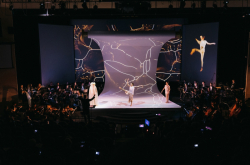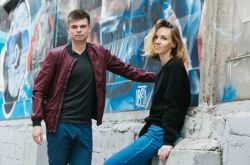How did you get the idea for your project?
In 2011, my friend Maria Otrutskaya worked on her thesis project. The topic had to do with devices for people with disabilities; Maria developed a cutting board. It had good design, but as of now, it is already outdated, and a lot of new technologies that could be made use of have appeared since then.
Six years later, in August 2016, we returned to this concept. We had several ideas, so we’ve decided to launch a startup. To do that, we began consulting with doctors, tried tying up one of our hands to better understand the problems people with disabilities face - to put it simply, we decided to start from scratch. We knew that the issue is relevant, and needs a solution. We ended up doing everything anew. We used the experience from the previous design - Maria shared a lot with us. Unfortunately, she had to leave the project at a certain point, as we couldn’t combine working on it with her hobbies.
 Project Grabby
Project Grabby
After she left, it was me who developed the project as a startup, a business model. I used some classical examples to learn how a project is scaled, how it is commercialized. As people with disabilities, namely people with only one hand are quite narrow a target audience, I got the idea to make the project good for not just them, but anyone. In other words, the carving board had to be both functional and attractive, so that everyone would want one. Why not turn people’s capabilities into opportunities?
So, we expanded the target audience. Many people like talking on the phone while doing chores, some of those who’ve come to my presentations were parents who constantly have to hold their younger children. These people also found my idea attractive. In the end, we’ve decided to make a carving board that would be great for everyone.
At the contest, you participated in the Co- category which focused on combining design and functionality. When you were working on your project, which examples did you draw from? What makes Grabby unique?
When I did my first design, I intuitively understood that there was something I did wrong. So I turned to Grabby’s co-author - Marina Egorova. She is also a designer, from the Stieglitz State Academy, we met at ITMO University on a joint lecture on collaborative design.I had her contact info and I recently got in touch with her to ask her to help me with the project, as her vision interested me. Her boyfriend, who has already graduated from the Academy, proposed an idea based on vacuum-packed coffee. It turned out that there’s already an industrial counterpart - a grabbing hand.
As for how the carving board works, let’s say you have a jar of pickles you have to slice. You place the jar on the board’s “sandbox” (we use grinded coffee for it), the coffee encapsules the jar, then we press the “aspirate” button. The coffee becomes stiff, forming a groove shaped for the jar, and the board holds it tightly. Thus, we can open it with one hand. We stop the aspiration, remove the jar from the board and take a pickle. Yet, how does one slice a pickle with one hand? We place it on the board and repeat the process.
 Nadejda Abdullina at Lexus Design Award 2018 Russia Тор Choice. Credit: Nadejda Abdullina's personal archive
Nadejda Abdullina at Lexus Design Award 2018 Russia Тор Choice. Credit: Nadejda Abdullina's personal archive
Point is, you can get the board to repeat the shape of any object. The board itself consists of several layers. The bottom one (which comes in contact with the table) is made of silicone. The next one is the board with a motor that aspirates air. There are lots of small holes in the board, all covered with fabric, so that coffee doesn’t spill out. All of that is covered with a kevlar layer, as kevlar can’t be cut. As of now, the most complex issue is having to decide on the kind of fabric, as there are many of properties we have to mind. We’ve chosen coffee as it’s used in the industrial counterpart we’ve based our project on. Also, coffee can be upcycled, which corresponds to the contest’s philosophy.
Why did you decide to participate in Lexus Design Award?
I got really inspired by visiting LEXUSDOME. In September, I went to Moscow and just didn’t know what to do there, so I decided to go an exhibition at LEXUSDOME. They offered a really spectacular tour. The organizers invited the visitors to an artificial forest with glittering firebugs and really clean air. You walk in darkness along a flagged path, and the mirrors all around give the illusion of the forest’s endlessness, and firebugs fly all around. While you do that, you are told how Lexus works, about their values and philosophy.
 Lexus Dome. Credit: trendymen.ru
Lexus Dome. Credit: trendymen.ru
It was there that I learned of the contest. I looked through the previous years’ winners on their website, and understood that I can win with my carving board project. To understand what they like, the style they prefer, I started making a mood board. I got many magazines, cut different elements that i liked, chose the atmosphere and locations - mostly nature, noticed that there’s lots of air in these images. This is how I figured their signature approach - “lighter than air”, and created a collage that expressed it. I then looked up similar concepts on behance, and made a 3D model of the carving board.
One has to understand that this is future, this is concept design. Meaning that this is not some startup that you can launch any other day, or some production you can easily scale - it is not about the costs or manufacturing techniques. This is about one’s ability to look into the future. At FabLab, I’m often told that my ideas are unreal, too expensive to produce, but they are what the future of design is about.
How long did it take to develop your project?
I’ve been working on this project since August 2016. First, I learned about people with disabilities, their needs and the needs of their relatives. In the course of a year, I created three of four designs. The final version was completed some three weeks before the contest. On September 16 I went to Moscow, then spent a week studying the materials I brought back, and started finalizing my project.
As of now, I have it as a visual prototype, and I am working on prototypes at the FabLab. I’m currently finishing the fifth one. I was presented with a vacuum board used for a milling cutter; I spilled grinded coffee on it, wrapped it up and made a working prototype. It’s still crude, but it works. What’s most important is that now I know what to do next. These prototypes gave me an understanding of the criteria for my project.
 ITMO's FabLab
ITMO's FabLab
In August my friends gave me an idea when they told me that there are resources I can use to bring my design to life. It would be more expensive than what I planned for the startup, and be it not for the contest, the project would have never been completed. Thanks to this new development and us winning the contest, I got the desire to continue. This summer, I also received an award for the best startup in social entrepreneurship - this achievement also motivated me.
You won a trip to Milan Design Week 2018. How will that benefit your future work?
We are very anxious about the trip, as it gives us an opportunity to not just go to Milan Design Week, but also present our project there. We’ve already passed the Russian round and won a four-night stay in Milan during one of the city's peak weeks. Best designers from all over the world will gather there, and showcase concepts concepts that are far ahead of the current design trends. If we pass the global round, we will get funding for a prototype.
 Milan Design Week. Credit: ria.ru
Milan Design Week. Credit: ria.ru
As for how such an achievement can benefit my work, I can already tell that my employers are starting to see me as a professional of a much higher level now that they’ve learned that I was nominated for the Lexus award. Now, I can already position myself as a more proficient designer and set higher prices. I’ve found my place in my field of work, I develop and learn - as at the moment, I’ve only been in this field for a year. I’ve grown to enjoy getting experience from completing projects for the industry, as they don’t really teach you economics when you’re studying design, and economics is really important. You add some element, and it turns out to cost some 300,000 more.
How do you plan to develop Grabby, as well as your other projects?
As of now, I perceive the carving board project as my hobby that I do in my free time. Although I have to say that this hobby offers good opportunities. I’m studying English right now - the trip to Milan is a good motivation, as I expect to find partners there. All in all, I’ve come to understand that I lack experience to develop a business model, so now I learn from the projects I do as part of my job.
I already have the first orders, and I have the opportunity to mass-produce some 5-6 thousand units in China. When I flesh out the customer interaction process, launching a business will become possible. As of now, I’m working on design of hookahs and industrial pumps with Maria, who was my partner when we first started to develop the carving board project.





